The Gothic Cathedrals of the Isle-de-France
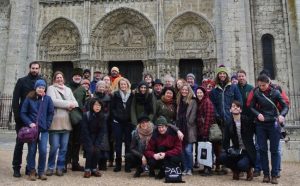
This is the third year that we have run a medieval study trip for first year carvers and conservators. This year the generous grant from the Stuart Heath Charitable Settlement allowed us to extend our range geographically into France, and increase the length of the trip from 3 to 4 days. This allowed us to make a tour of most of the major Cathedrals of the Isle-de-France, which encircle Paris with convenient travel distances between.
The primary aim of this trip is to allow students to contextualise what is being learnt in Art Histories study, as well as their practical studies in the workshops and studios. The opportunity to physically experience the great Cathedrals on site, rather than through photographs, allows a much deeper understanding of the interrelationship of the architecture, sculpture and glass painting. Also it is possible to easily follow the chronological development of the Gothic style in its various phases and forms. The Early, High and Late Gothic periods are all perfectly exemplified in this closely related group of buildings that were at the epicentre of the development of medieval art through the 12th-15th centuries.
Given their age and the vicissitudes of time and history, these buildings also provide the perfect opportunity for staff and students to explore issues around the restoration and conservation of ancient monuments. Reims Cathedral, for instance, given its location on the front line in WWI, was tragically shelled leading to a disastrous fire and the collapse of some parts of the building, necessitating a major restoration programme. At the time this shocking event had an impact across Europe, much like that created by the recent destruction of the Bamiyan Buddhas and Palmyra by ISIS forces. More recently Chartres Cathedral has undergone a radical and controversial clean internally which has led to heated debate in heritage circles. There is no better place to discuss the issues arising from events like these than in the buildings themselves, where the effects of damage, decay, restoration and conservation can be seen directly.
Apart from the academic benefits, the social opportunities of such trips are also very significant, allowing conservation and carving students to get to know one another better, as well as staff. Given the generous sponsorship, we were also able to offer discounted place to students from other years, as well as to staff, and in the end a total of 37 students and staff participated in the trip.
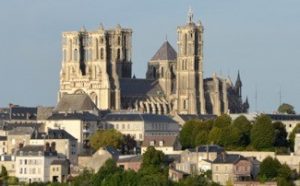
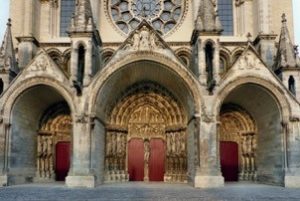
LAON
We set off on the Friday with a long coach journey that delivered us to the start of our itinerary at Laon Cathedral. Dramatically silhouetted on a hill that dominates the surrounding countryside, the west front was washed by the late afternoon sunshine when we arrived. Memorably, after the coach took a wrong turn, we were given a police escort to the set-down point. Laon is a little visited masterpiece of early Gothic design, so the perfect place to start the visit, as its powerfully modelled façade and richly sculpted portals were highly original, famous throughout late 12th century Europe, and very influential in the later development of portal sculpture. Following installation in our hotel, the evening was spent eating in the varied restaurants of the old medieval town.
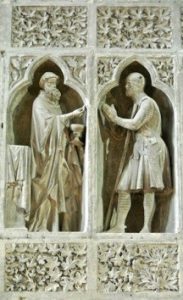
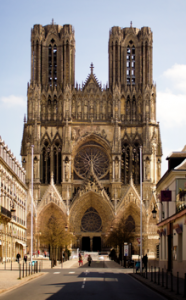
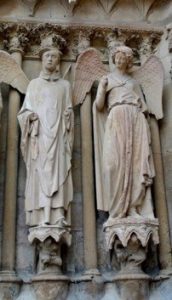
REIMS
Saturday found us at Reims, sadly out of sequence chronologically in our list of Cathedrals, but the influence of the Laon experiments on the facade of Reims is very apparent. Reims was the coronation church of French royalty, and a centre of carving, particularly notable for its figure sculpture as well as its naturalistic foliage carving. In England, exquisite examples of this style are found at Southwell and York Minster, so close to the Reims spirit that the English carvers must have visited and studied it. Some of the third years who participated in the trip were able to remember seeing the Southwell carvings on our first medieval study trip, which took us up the east side of the country to Lincoln ,York and Durham.
We had two Frenchmen on the trip, one a student, the other a tutor, Ghislain Puget, who knew the building well having worked on its restoration.
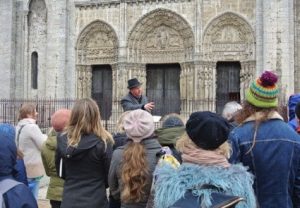

CHARTRES
By Sunday we had reached Chartres, where we had an extended stay, given the importance of the building in the history of Gothic architecture. Although it was the first great monument of the High Gothic style, its West Front carvings pre-date the rest of the building by some 50 years and are themselves the best and most perfectly preserved example of early Gothic sculpture. Despite the bitterly cold weather, the group enjoyed a thorough exposition of the sculptures by Michael Paraskos, our Art History Tutor.
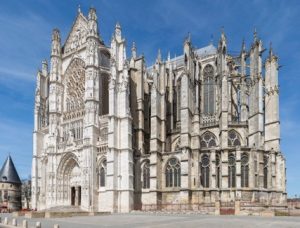
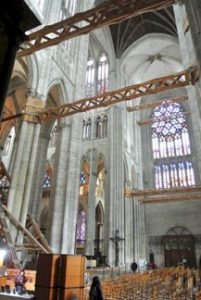
BEAUVAIS
Next on the itinerary was Beauvais which is famed for the tallest vault ever built in the Gothic period. Unfortunately, in their ambition, the builders overreached themselves and the vaults collapsed soon after construction. Undaunted, they were rebuilt, and remarkably, despite not completing the nave, a tower and spire of even more spectacular height was added later. It too collapsed, so Beauvais remains a heroic fragment, still beset by problems of stability as evidenced by the ugly wooden bracing to be seen inside the church. This was the coldest day of the trip, with snow whipping round our ears as we studied the building. The buttresses supporting the vault of the choir are so tall and spindly that the whole structure needed to be made more rigid with the introduction of tie bars at a high level. In ornamental terms, the building is very interesting, as renaissance forms start to appear amongst the gothic foliage of the north transept portals.



AMIENS
By Monday lunchtime the road was leading us back north-west to Calais, via Amiens Cathedral, roughly contemporary with Reims but fortunately less damaged in WWI. Consequently, the choir furnishings remain intact and feature some beautifully preserved late Gothic polychrome carvings facing the aisles, whilst the wooden choir stalls are extraordinary, featuring much virtuoso late Gothic carving. We managed to obtain special permission to enter the choir to sketch and photograph these closely, much to the delight of the woodcarvers. One sharp eyed student identified a small WWI memorial cut by Eric Gill, the lettering of which really stood out against the indifferent French lettercutting of the period.



FONTAINEBLEAU AND THIEPVAL
Although focus of the trip was on the study of medieval art and architecture, we also managed a couple of other visits en route. The first was to the Palace of Fontainebleau, the next largest royal palace to Versailles, famed for the Galerie Francois I, with its Early Renaissance carved panelling, and its figurative stucco decorations by Rosso and Primaticcio, who were amongst the first to bring Renaissance forms to Northern Europe from Italy.
Finally, we concluded with a stop at the WWI Memorial at Thiepval, in the form of a monumental arch designed by Lutyens and poignantly inscribed with the names of over 70,000 servicemen who died in the surrounding fields but have no known graves. It seemed right to stop here in this centenary year of the end of the Great War.
Given the generous funding available to support it, this was the most ambitious and successful medieval study trip to date. First years were heavily subsidised, and smaller subsidies were made available to other students as well as tutors. The increased numbers attracted by the bargain prices meant that costs per person could be kept really low (£135 for first years and £200 for others).
Next year we may repeat this model of coach travel to nearby European centres, but are also considering the possibility of travelling further afield by budget airline and running a single location trip.


